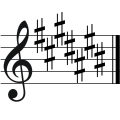C-sharp major
![]()
C♯ is a redirect to this article. For the programming language, see C-Sharp.
C-sharp major is a key of the major tonal family, based on the root note C-sharp. The key of C sharp major is written in musical notation with seven crosses (F sharp, C sharp, G sharp, D sharp, A sharp, E sharp, His). The corresponding scale and the fundamental chord of this key (the tonic c-sharp-e-sharp-g-sharp) are also designated by the term C-sharp major.

![]()
![]()
![]()
![]()
![]()
![]()
![]()
![]()
![]()
![]()
![]()
![]()
![]()
![]()
![]()
The key character of C-sharp major is often described as delicate, light and bright.
Works
Works in C sharp major are comparatively rare. More common is D flat major, which is identical in harmony (not in tone color), since (unlike C sharp major) it has only 5 accidentals and thus lies in the circle of fifths. Johann Sebastian Bach's preludes and fugues in The Well-Tempered Clavier are best known, especially the prelude of the first part. Even if a work begins in C major and is transposed up a semitone in the course (often by a regression), the transposed part should be notated in C sharp major rather than D flat major.
Key classification
| Keys and their accidentals | |||||||||||||||
| Portent: | 7 ♭ | 6 ♭ | 5 ♭ | 4 ♭ | 3 ♭ | 2 ♭ | 1 ♭ | 0 ♭/♯ | 1 ♯ | 2 ♯ | 3 ♯ | 4 ♯ | 5 ♯ | 6 ♯ | 7 ♯ |
| Major keys: | Ces | Ges | Des | As | It | B | F | C | G | D | A | E | H | F# | C sharp |
| Minor keys: | as | it | b | f | c | g | d | a | e | h | F# | cis | gis | dis | ais |
Questions and Answers
Q: What is C♯ major?
A: C♯ major (or C-sharp major) is a major scale based on C♯. Its key signature has seven sharps.
Q: What is the relative minor of C♯ major?
A: The relative minor of C♯ major is A♯ minor.
Q: What is the parallel minor of C♯ major?
A: The parallel minor of C♯ major is C♯ minor.
Q: What is the enharmonic equivalent of C-sharp Major?
A: The enharmonic equivalent of C-sharp Major is D♭ Major.
Q: How does tuning a harp to play in this key affect its sound quality?
A: When a harp is tuned to play in this key, all its pedals are placed in the bottom position which makes it less resonant as all strings are made shorter.
Q: Why do most composers prefer using D-flat Major instead?
A: Most composers prefer using D-flat Major instead because it has just five flats, compared to seven sharps for the same note in the key of C-sharp Major.
Q: Are there any well known pieces written specifically for this key signature?
A: Yes, Johann Sebastian Bach wrote Prelude and Fugue No. 3 from both books of Well Tempered Clavier in this key signature, Franz Liszt changed keys from D-flat Major to this one near the beginning of his Hungarian Rhapsody No 6, Maurice Ravel used it as tonic key for Ondine from his piano suite Gaspard de la nuit and Louis Vierne used it as final piece for Messe solennelle.
Search within the encyclopedia














